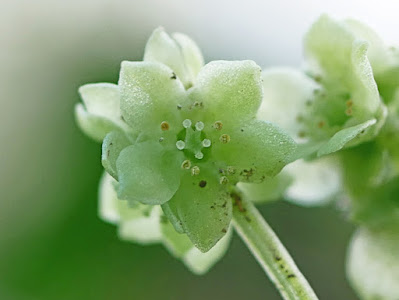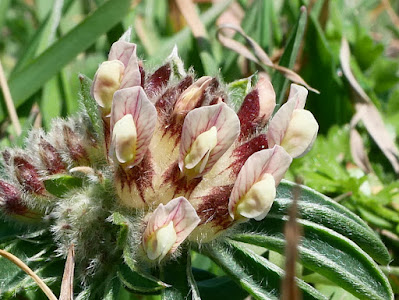I dedicate this blog to my dearly beloved mother who recently passed away from a stroke. She had a good innings and lived a full 92 years, but it's still a shock when you lose a parent. She always took an interest in my blogs and read each one and even made decoupage birthday cards from photos of the flowers I took. I miss you Mum. 🙏
****
Spring is now well under way as I write, and a plethora of early flowering species are enjoying the frequent rains we have had in Cornwall so far this year. The last few years (though in Kent) were drought years in Spring and the small annual species suffered as a result. With the refreshing rain almost every other day of late, the Spring flowers are having a good year. Clifftops are covered in carpets of Spring Squill and Sea mouse-ear and inland the moisture loving Wild Garlic (Ramsons), Bluebells and tiny Speedwells are also blooming abundantly.
The following photos are a sample of what I have found on my normally short walks at this time of the year.
First up is a small plant with tiny flowers called Blinks. Probably because if you blink you'll miss it walking past. I've never seen it in flower until now and predictably I only had my phone with me so I couldn't get close up photos of the flowers. I found this on an industrial estate near Indian Queens. It doesn't like competition from other plants, so the freshly disturbed soil was to its liking. You can just see a flower in the bottom right of the picture.
Montia fontana
Another tiny plant that doesn't compete with other plants is Mossy Stonecrop. This is a small prostrate species that reddens with age and puts out miniscule flowers. I found a patch by Wadebridge sewerage works on the Camel Trail, a new record for that area. No flowers on it yet though.
Crassula tillaea
Many trees are flowering now and one of the first is Cherry Laurel. It is an alien species that regularly escapes from gardens into the wild. Birds eat the fruits and spread it far and wide. It's invasive and can dominate large areas of woodland at the expense of other native plants as its evergreen foliage shades them out. Though looking at the flowers below, you can see why people like it and the leaves staying green all Winter gives colour to their garden.
Prunus laurocerasus
Bumblebees, solitary bees and bee flies (below) are now active. The Bee Fly only drinks nectar with its long proboscis and often hovers to do so, beating its wings at hundreds of times a second to maintain stability. Adult females
lay eggs in or near burrows of host insects such as beetles, wasps, and
bees. A few days later, larvae hatch from the eggs and feed on the food
left for larvae of the host insect and on the host insects themselves. Below is the Dark-edged Bee-fly.
Bombylius major
The first flowering rush of the year is the Field Wood-Rush. It only grows to about 10cm tall (usually less) and is common in short turf and grassy areas.
Luzula campestris
On a road verge near Wilsey Down I came across possibly a thousand flowering Butterbur. This is an uncommon species and likes to have damp soil. In Kent it was usually found in the flood areas around streams and rivers that would be underwater and dry out in the spring. Here it seems to do well on a variety of road verges, often nowhere near running water.
Petasites hybridus
An impressive spike of flowers. Huge leaves follow once they die back.
I was surprised to see some fresh looking fungi on my walks. I expect it in the Autumn but it's uncommon in Spring. Perhaps last year's drought spurred them into "late" fruiting?
Here's some nice looking Mica Inkcaps found by the River Ottery.
Coprinellus micaceus
I scoured the west bank of the River Ottery on the botanical Cornwall/Devon border, looking for Alternate-leaved Golden Saxifrage. This was based on an old article in Cornwall Botany that some may have been found on the opposite bank. This later turned out to be doubtful and unsurprisingly, I failed to find any. Of course, there were thousands of Opposite-leaved Golden Saxifrage to admire too, as shown below. Look at the leaves below the flowers and you can clearly see they are opposite.
Chrysosplenium oppositifolium
I took a trip to Respryn Bridge on the River Fowey in March to visit the Wild Daffodil site there (see last blog) and returned a couple of weeks later. I found more Wild Daffodils along the banks of the River downstream, but also a sea of Pink Purslane. This is a naturalised garden species that seems to be quite common in the wild in Cornwall, I have even found it on the edges of moors. It doesn't seem to affect native species adversely, so it's nice to see its pretty small flowers in the sunshine.
Claytonia sibirica
I also found stands of Redcurrants here, another frequent find in Cornwall's woodlands. This one got sufficient light to flower under the deciduous trees around it.The yellowish flowers are on the dangly stems hanging down beneath the leaves. They will be pollinated and ripen into bright red tasty berries. However, I never eat them, I leave them for the wildlife.
Ribes rubrum
Spring is the time of year when you realise that taking a walk can be dangerous. Adders have come out of hibernation and are surprisingly difficult to spot when not moving. Already this Spring, I've come close to treading on two of them. Their bite is venomous, so take care when in the wild. Having said that, the Adder below was in Tintagel churchyard where you'd think it was safe to walk and not on the coastal heath nearby. Fortunately, it was basking, warming up in the sun before going hunting. As such, I could back off quietly without disturbing it. At least being a botanist, I am mostly looking down. If I were a birdwatcher, I'd probably have stepped on one by now.
Vipera berus
I took a trip to Cligga Head near Perranporth in early April to generally record. Within a few metres of each other I found three Fumitories. One was Common Funitory which I didn't photograph (it's small and common!) and the second was Tall Ramping Fumitory below. What makes this species stand out is that the flowers are quite narrow with smallish jagged sepals and mostly the top petal is the same colour as the body of the flower. Most other Ramping Fumitories have black tipped upper and side petals.
Fumaria bastardii var. bastardii
The final Fumitory was the amazing and very large flowered, Cornish (or Western) Ramping Fumitory. It's endemic to Cornwall and mostly West of the River Camel. No-one really knows why it hasn't spread further East. It's easily told apart from the others by having large flowers (12-14mm), a white rim around the top petal (prior to pollination) and the flowers having a spanner shape.
Fumaria occidentalis
Note the white rim around the top petal that fades to pink after pollination.
A walk along the River Allen near Lemail revealed a couple of patches of Moschatel. It's a small cubed shaped flower with flowers on all 4 sides and also on the top, giving it a unique shape. Hence one of its common names being "Town Hall Clock".
Adoxa moschatellina
On another lane near the Polmorla Stream west of Wadebridge was a nice stand of Climbing Corydalis. Its flowers superficially resemble those of the fumitories, but they are quite different close up. These seem to like it shady and damp and are relatively common in the lanes east of Wadebridge.
Ceratocapnos claviculata
It wasn't until the 15th April that I saw my first Cuckooflower of the year in flower, about a week behind those further East in England. Always delightful to find, they like damp, but not waterlogged areas.
Cardamine pratensis
Nearby I noticed a large shiny beetle going about its business. After some research on https://www.buglife.org.uk/ I found it was a Violet Oil Beetle. It was about 3cm long and had an indented thorax at its base differentiating it from lookalike species.
Meola violaceus
On the north coast, Little Robin were flowering in their hundreds along cliff paths. It is closely related to Herb Robert but has yellow anthers, no white streaks on the petals and the petals overlap haphazardly. The flowers and leaves are smaller and far less hairy too.
Geranium purpureum
There were now carpets of the strikingly blue flowers of Spring Squill on the cliffs, mixed in with Sea mouse-ear and Common Storksbills. A wonderful sight.
Scilla verna
Changing Forget-me-not on the clifftops with its characteristic unfurling cyme of tiny flowers. These change from white or yellow to blue as they age, hence their common name.
Myosotis discolor
Of course, April is Dandelion time and about the only month where you can positively identify one from around 250 micro species. I found this tiny species below on the cliffs at Pentireglaze.
There were also two patches of Upright Chickweed here, an uncommon species which lives in short turf on sandy soils. The flowers only open in full sun.
Moenchia erecta
The first flowers of the Early Purple Orchid have opened on road verges near St Kew Highway. Last Spring I counted 81 spikes on one verge, but this year it had been mowed early and this was the only one that made it. Mowing is a double edged sword as on the one hand mowing yearly creates a habitat for the orchids (and other wildflowers) that would otherwise be swamped with Hogweed and Alexanders. On the other hand, mowing at the wrong time wipes out a year's worth of seed from these plants. Mowing at the beginning of March and again in early Autumn is all that is needed for wildlife to thrive on road verges. I can't blame the council here either as a local landowner appears to have mowed these verges to make it neat and tidy outside his home, despite that he does not own the road verge.
Orchis mascula
Kidney Vetch is just opening its flowers now which are usually bright yellow. Cornwall is blessed with many colour forms and eben dual coloured forms. Below is a cream coloured flower with purple lines on the standard petal and calyx below, stunning!
Anthyllis vulneraria
Below is the red form given the name "var coccinea"
The last flower in this blog which takes us up to the last week in April was a pink form of Scarlet Pimpernel. One day I might find the blue form too!
Lysimachia arvensis forma carnea
There's already several plants lying in wait for my next blog, including several Violet species. Bog and beach plants are beginning to awaken and as each week passes, I won't be able to keep up! So get outside and take it all in, it's a wonderful time of year to be outside.
Take care
Dave



































No comments:
Post a Comment
All comments are moderated before publication, so please don't bother spamming me, thank you. Genuine comments most welcome.